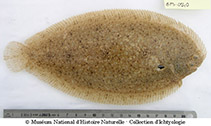| Family: |
Soleidae (Soles) |
| Max. size: |
40 cm SL (male/unsexed); max. reported age: 15 years |
| Environment: |
demersal; brackish; marine; depth range 5 - 350 m |
| Distribution: |
Eastern Atlantic: northeastern to southeastern Atlantic; perhaps Gulf of Guinea; the Mediterranean Sea and Black Sea; reported from Suez Canal (Ref. 32649); and Sea of Azov (Ref. 4710). |
| Diagnosis: |
Dorsal spines (total): 0-0; Dorsal soft rays (total): 69-87; Anal spines: 0-0; Anal soft rays: 53-73; Vertebrae: 40-48. Last ray of dorsal and anal fins joined by a low membrane to the base of the caudal fin. Supratemporal branch of lateral line forming an arch. Anterior nostril on the blind side prominent forming a large round rosette, its diameter equal to that of the eye. Lower lip on ocular side undulated with about 6 lobes. Length of both nasal tubes and scales above it on the ocular side about equal. Pectoral fin on the ocular side with a black botch with a white margin except at its base; this blotch often interrupted by light space or accompanied by dots or streaks on one side or the other (present in fresh specimens from coast of Israel (Ref. 32649). Brownish yellow or reddish brown in color with obscure pale blotches and specks (Ref. 3200). |
| Biology: |
Found on gravel, sand or mud. Feeds on a wide range of small marine bivalves; mainly on crustaceans such as amphipods, mysids, shrimps, decapods, bivalves and polychaetes (Ref. 4710). |
| IUCN Red List Status: |
Least Concern (LC); Date assessed: 20 May 2013 Ref. (130435)
|
| Threat to humans: |
harmless |
Source and more info: www.fishbase.org. For personal, classroom, and other internal use only. Not for publication.

